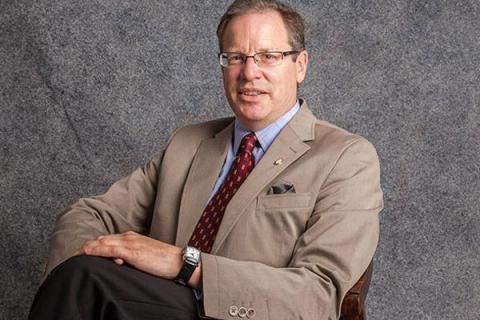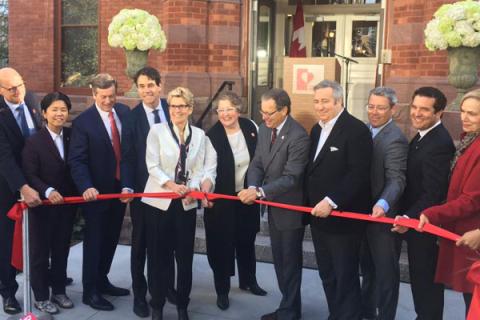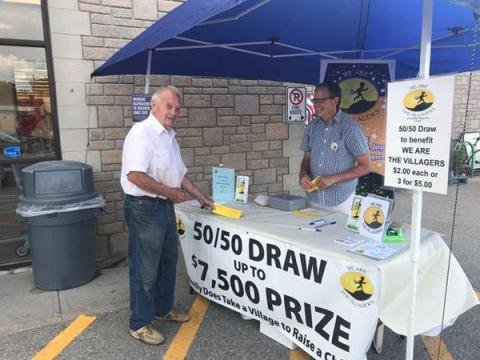
A successful financier who was named one of the Financial Times of London’s OUTstanding LGBT Global Business Leaders in 2017, Bonham’s past ventures have included co-founding BPI Financial Corporation and establishing 20 prosperous mutual funds, founding Strategic Value Corporation and another 25 mutual funds, and owning Stony Ridge Estate Winery in Vineland, using some of the proceeds derived from the sales of those businesses to fund his charitable causes.
Among the substantial benevolent contributions that Bonham, a Senior Fellow of the University of Toronto’s Massey College, has made include Casey House Hospital; 21 two-year full graduate scholarships for MBA students at the Rotman School of Management; establishing the Mark S. Bonham Centre for Sexual Diversity Studies at the U. of T., and the Egale Centre, the city of Toronto’s first LGBTQ homeless youth shelter, now under construction with a planned a 2019 opening of 35 units near Dundas and Sherbourne.
An author of five books, including Becoming 150: 150 Years of Canadian Business History (University of Toronto Press, 2018) and the soon-to-be-published A History of the Canadian Financial Industry 1900 to Present, Bonham took time out of his busy schedule to talk philanthropy with Samaritanmag.
You got involved with philanthropy at quite an early age. What was the impetus for doing so?
It really was my own personal characteristic in that I’ve always had an entrepreneurial spirit, those types of ventures like creating a community newspaper, handwriting it out on paper and then delivering it to all the local houses in the neighbourhood. I had a local carnival I called “Carnifair” and I made money doing that. To me, it was sort of an entrepreneurial approach, so it was some inherent characteristic in me to do those types of ventures. I can’t really explain why I enjoy doing them. I wouldn’t say there was any event that triggered it — just more of a characteristic streak. I enjoyed those types of activities, being involved in the community and raising funds for various causes.
One of your first major donations was to Casey House. What attracted you to contribute to it? Has the stigma surrounding HIV/AIDS noticeably changed over the years?
Yes. How I originally got involved was that I had sold my business, so I had come into a lot of money and I’d wanted to give that back to the community. So, I did some looking around to see where my contributions could have a big impact — specifically in the LGBTQ community, being an LGBTQ person myself — and wanting to give to those sorts of social issues. I met June Callwood and she was a very powerful individual who had an impact on the community fairly immediately, so I looked into my contribution and what sort of difference that would make. It became quite evident that — given the stigmatization on that issue in society — I felt that I could step up to the plate and make that type of difference in terms of breaking down those stereotyping and stigmatizing issues. I felt that it was a meaningful project to participate in. That’s how I got initially involved.
I’d say it’s had a significant impact on the community over time. I would still say that there is stigmatization and stereotypes around the issue, but it’s significantly less than it was and the project has come to fruition. The nature of AIDS has changed significantly over that time. It’s less a death sentence, if you will, today, but it’s now more prolonged illness and a lot more other illnesses become attached, such as… if you deal with HIV/AIDs over time, you have to live with more side effects such as kidney failure and stuff like that. Life may be prolonged, but there are a lot of side effects to AIDS that have to be dealt with.

Is there anything better we as a whole could do to reduce or eradicate that stigma?
That’s one of the reasons education is so important to me in my giving, is because I think a lot of it is just education and making people aware of the diseases and sources and so on. That’s why I’m also a big supporter of education — because I think that education plays a very important role in all of these issues.
One of the first endowments you gave was to the University of Toronto for your teaching fellowship. At that point, were there a lot of topics relatable to LGBTQ studies?
That’s a more recent development. At that time, at U of T there was only one course on sexual diversity issues. We have grown that program into a full-time undergraduate degree granting course and a graduate degree granting program, so it’s grown from being one course with 30 students to a degree program with 350 undergrads and 25 masters and Ph.D students. The growth has been phenomenal. The research that’s now coming out of this centre is in symposiums and conferences and the international reach of the program is just quite mindboggling today.
It’s called the Mark S. Bonham Centre for Sexual Diversity Studies. How does that differ from what you did earlier? It’s obviously expanded.
For example, we do a lot of community outreach now in terms of the research and community work in terms of conferences and symposiums and printed matter, published research and so on. There’s also a considerable network of research centers that are working on issues around sexual diversity that just didn’t exist before, that we either were definitely part of it or else we also created these networks.
There are journals that have been created now that collect published research material on various sexual diversity areas, and this is not just social research, but legal, medical and technological research. It’s very diverse in terms of subject matter as well. Before, there was very little research being done outside of social issues — now, it is multi-disciplinary and covers about 42 different disciplines. When we started the Centre it was really focused more on the social issues as opposed to the medical issues or artistic issues or things like that.
You also campaigned for Egale, which is the LGBTQ homeless centre. Is homelessness a growing problem facing LGBTQ youth? Is this the first opportunity you’ve had to directly address it?
This is definitely a growing problem. The city of Toronto came to the Bonham Centre almost five years back and said, “We have a problem that we don’t know how to deal with and this is the issue: that the proportion of homeless youth in the city, about 40 per cent of that, is LGBTQ and it’s growing by leaps and bounds. We don’t know how to address the issue and we need help from you to do that.” So, at the Bonham Centre, we just didn’t want to jump into the field not knowing what we were doing, so we spent about two years doing some research in the field wondering, looking at why is there a sudden surge of LGBT kids and homeless youth on the street?
We did that work and learned, as a part of that with Egale and Ed Clark at the TD Bank, because he’s very big on homeless youth as well, we brought him into help us with this. Egale initially set up a crisis counselling centre that we operated for two years, just to survey the market and find out where these kids are coming from — why are they running away from home or being kicked out of the house — what are the issues here?
We wanted to make sure we came up with a solution that was practical, feasible, and would attack these issues — whatever these issues were. It did become quite evident that these were engrained issues of kids running away from home or being kicked out was because these kids were either coming out or discovered as being gay and their parents just threw them out on the street. These are kids as young as 11 years old. So, that’s when we decided that a facility that would combine career counselling with emergency housing shelter and transitional housing shelter would be the best solution — a three-pronged approach to it. Then, we set about putting that idea into place and we raised over $16 million in six months to then create this LGBT homeless youth centre. The mind-boggling thing was that absolutely no one said no to our request to help out — whether at the corporate level or at the individual level. I’ve never been able to raise that amount of money so fast for a project before, and never envisaged that it would come together that quickly. Now it’s halfway into construction and we’re looking to open in the summer of 2019.
So disenfranchised LGTBQ youth will not only get emergency help…
But they’ll get counselling as well to get them back into school, for example, or, into the career stream. It’s not just giving them a roof over their head and saying, “Okay, sort your life out.” There will be a counselling program attached to it that the kids will be a part of.
You also contributed to the Inside Out Film Festival. What’s the greatest thing you’ve taken away from that in terms of bringing films to public attention?
Well, it’s something that I’ve seen tremendous maturing within the community over films. In fact, there has been tremendous growth but also tremendous change in terms of quality of production and thematic material that comes out of the industry. Sort of watching from being a niche programming element within a film community to now being quite mainstream. You have films like Boy Erased, which just came out — or I guess the first big one was Brokeback Mountain, so it shifted from being sort of a very small niche topic, if you will, to being very mainstream. And what I find attractive to that is again the educational element in terms of showing that the outreach community is a legitimate, longstanding, historical part of society — and the issues are no different than any other community’s issues. It’s been great to see the maturation of the film industry in terms of LGBTQ coverage for that industry.
Over the past 20 years there seems to have been great progress in the understanding, tolerance and acceptance of the LGBTQ community, but obviously there is still work to be done. What are some of the changes you’ve seen and what are some of the hopeful signs where people are saying, “live and let live.”
A lot of that relates to Western and developed countries and Canada is obviously a leading country in terms of the change and level of intolerance and moving towards significantly more tolerance, but it is very much a country-by-country issue. So, this is still an international issue that has to be worked on, and what we’re finding is that Toronto, specifically — and Canada as a whole — is very much a global hub around LGBT thinking in terms of activism, artistic programming. We’ve really created in Toronto , a center point on these issues. What we find with the Bonham Centre at the University of Toronto, is that we have students coming from South America, China, Europe and Eastern Europe coming to the Centre because of the reputation of Canada and Toronto, as having maturity and a tolerant society around these issues. They’re coming from societies that are less tolerant, so they want to learn more about why that happened and how they can be a part of that change back in their home country. I mentioned we have 350 students now — I believe that well over half of those students are non-Canadian students that came to University specifically for the program because Toronto is a thought and hub of research around the issues. I think that’s a tremendous feather in the cap for the city and the country.
What are some of the issues you wish would have more attention paid to them?
That’s a good question. I’m pretty satisfied with the attention across the board in terms of everything from bullying in schools to changes in the legal system to changes in the health care program. I think things are going very well and a lot of positive changes have occurred in the last 20 years that perhaps people would have never envisioned. We just need to be part of the overall community, part of the #MeToo issues; part of the Black Lives Matter issues; whatever the issues of the day are — and part of those community issues. I can’t point to one specific thing and say, you know, we’re just not doing a good job at it. It’s been a very satisfying journey over that past 20 years.

When did you become aware of the children’s charity We Are The Villagers? I understand that that contributes to children from low-income households in Northern Ontario.
It provides funding for kids of low-income families to participate in extra-curricular activities, so it can be anything from hockey — which is $1,500 a year in registration fees just for kids to play hockey there, let alone equipment — to dance to guitar lessons to music lessons to after school math and English tutoring. It’s an income-based program that kids coming from single-family homes — 30 per cent of our kids live with their grandparents, for whatever reason — and they can’t afford the $1,500 for their kids to take hockey lessons, so it’s really to make sure that no kid is left behind in terms of social and extra-curricular activities. Studies have shown how critical those are to developing a child’s social skills and career path. That’s what the program does — there are about 435 kids in the program in 19 different communities in Northern Ontario. It comes back to my interest in education in terms of developing well-rounded kids in knowledge-based issues of society. That’s where my interest in being a part of it comes from. A strong proponent of education in thinking that education is a key component to society in building a very well-informed, tolerant society on various issues such as this.
On that front, is there anything more that people need to understand or could be done about it?
A lot of people aren’t aware of the issues, especially in small communities in Northern Ontario, or even in Southern Ontario. They just don’t think about kids and how they’re our future. Just knowing that the issues exist and how they can help out very easily. It’s not a challenge to help out — it doesn’t always have to be financial — it can be just offering their services. But there are kids out there — their voices aren’t going to be heard. We have to stand up for those kids and let their voices be heard.
Tell me about the Ravine project.
That came out of the city of Toronto itself. I was chair and on the board of the Botanical Gardens for eight years and I’m still involved with that. The city recognizes that the ravine system is very unique to this city and being that unique, has an opportunity from many different angles to preserve and use it as a feature for the city — whether it’s attracting tourism, whether it’s facilities for residents and so on — the challenge is that the ravine system is deteriorating rapidly, through environmental issues and also through use. So, the city created this strategy committee to bring all the parties together that have an interest in the ravine system to come up with ideas and solutions to manage them better, to promote them and to cheer on sustainability. That’s where all of that has come from. It is city-driven, from the woman who just ran for mayor (Jennifer Keesmaat). She developed it internally with the city first, through various departments, and opened it up to the public and me being involved with the RBG is how I got involved with that project.
Obviously, you’ve touched a lot of people, but what’s the most profound thing that you have received in terms of a reaction for something that you’ve done?
The biggest thing I’ve been surprised by recently is the funding for the homeless youth centre. If anything that involves kids and involves our future and involves the welfare of our children, is top of mind with individuals is a thing that people can relate to very easily, is that raising the money for that was the easiest thing that Ed Clark, Martha McCain and myself did — and it just shows that when you bring these issues to the fore and you talk to people in our community, and say there’s an issue we have to deal with, we’ve done our homework and this is the way we feel, we can attack the issue and overcome it, and people will just rally around it and put their money on the table or their ideas or whatever and — so it’s really just reaching out to the community and saying we’ve got to solve these pressing issues. It’s been tremendously rewarding to see how the community responds to that positively.
Air Jordan 1